Ques. 2. Basic outlines of the classification of Fritsch and knowledge of modern trends in classification.
OR
Write an account of the classification of Algae. Indicate the modern trends in classification.
Ans. The classification of plants has undergone many changes since the time of Aristotle, whose pupil Theophrastus first grouped them into herbs, shrubs and trees. In the eighteenth century Linnaeus (1754) divided plants into four classes, one or which was cryptogamia (kryptos = hidden, gamous = marriage). Linnaeus was the first botanist who gave the name of Algae.
Different views have been held regarding the classification of Algae.
Harvey (1836) on the basis of colour divided algae into following three groups:
- Chlorospermae (Green Algae).
- Melanospermae (Brown Algae).
- Rhodospermae (Red Algae).
Pascher (1914, 1931) proposed a phylogenetic classification of algae. He classified algae as follows:
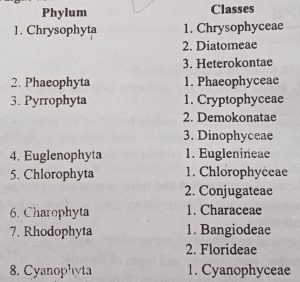
Afterwards Fritsch (1935), professor of Botany, University of London proposed a classification based on pigments present in plant body. His classification has been followed by M. O. P Iyengar (1949), one of foremost Indian Algologist and is widely acceptable.
Fritsch (1935, 44, 45) in his book “Structure and Reproduction of Algae”, has classified algae into following eleven classes:
- Chlorophyceae
- Xanthophyceae
- Chrysophyceae
- Cryptophyceae
- Dinophyceae
- Chloromonadinae
- Euglenidae
- Phaeophyceae
- Rhodophyceae
- Bacillariophyceae
- Myxophyceae
Dr. Fritsch’s classification is mainly based on pigmentation, assimilatory food products, and type of flagella.
The outline of the classification proposed by F. E. Fritsch is as follows-
- Class I. Chlorophyceae (Green algae): Chlorophyll predominant; food reserves starch (9 orders-Volvocales, Chlorococcales, Ulotrichales, Cladophorales, Chaetophorales, Oedogoniales, Conjugales, Siphonales, Charales). (BSC 1st Year Study Material)
- Class II. Xanthophyceae (Yellow green algae): Xanthophyll or carotenoids dominant; reserve food oil and leucosine; flagella two, unequal (4 orders-Heterochloridales, Heterococcales, Heterotrichales, Heterosiphonales).
- Class III. Chrysophyceae (Orange algae): Mostly flagellate, rarely filamentous; uninucleate; phycochrysin main pigment; starch absent; Flagella 1 or 2, unequal (3 orders-Chrysomonadales, Chrysosphaerales, Chrysotrichales).
- Class IV. Bacillarophyceae (Yellow or golden brown algae, diatoms): Cell wall siliceous; carotenoids and diatomin dominant pigments. Reproduction by cell division (2 orders).
- Class V. Cryptophyceae (Brown or red): Asymmetrical flagellated cells with 1 or 2 apical or subapical flagella. Xanthophylls or chlorophylls predominant in plate like chloroplasts; food reserves starch-like carbohydrates (2 orders, Cryptomonadales, Cryptococcales).
- Class VI. Dinophyceae (Dark yellow or brown algae-dinoflagellates): Carotenes, Xanthophylls and peridinin predominant pigment reserve food starch or oil; reproduction by cell division. 2. Subclasses – Desmokontae, Dinokontae). (BSC Botany Notes Chapterwise)
- Class VII. Chloromonadinese (Bright green algae): Unicellular biflagellate cells; chlorophyll predominant in readily arranged chloroplasts; food reserves oils; and cells with one trichocyst (only one order).
- Class VIII. Euglenideae: Chlorophyll predominant in oval, diffuse, or starshaped chloroplasts; motile by one, two or three flagella; unicellular or sometimes colonical food reserves parapylum (1 order).
- Class IX. Phaeophyceae (Brown algae): Branched, tufted filaments or completes of filaments to form prostrate or erect thalli; fucoxanthin dominant reserve food laminarin, leucosine or mannitol; flagella lateral or subapical in motile reproductive cells; reproduction by zoospores and gametes (9 order Ectocarpales, Tilopteridales, Cutleriales, Sporochnales, Desmarestiales. Laminariales, Sphacelariales, Dictytales, Fucales).
- Class X. Rhodophyceae (Red algae): r-Phycoerythrin dominant pigment; reserve food floridean starch; motile cells absent (7 orders-Bangiales, Nemalionales, Gelidiales, Cryptonemiales, Gigrtinales, Rhodymeniales, Ceramiales).
- Class XI. Myxophyceae or Cyanophyceae (Blue green Algae): e-Phycocyanin dominant pigment cells without a true nucleus (Prokaryotic: Motile cells and sexual reproduction absent (5 orders-Chlorococcales. Chamosiphonales, Pleurocapsales, Nostocales, Stigonematales).
During the last decade or so, Phycologists or students of algae have come to regard classification based solely on pigmentation as artifical and so the modern tendency in classification is to use a combination of characters such as the nature of motile cells especially with respect to food stored and finally the pigmentation of the cells, G. M. Smith (1955) gave a system of classification of algae as follows:
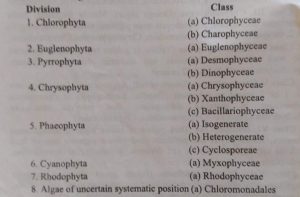
In 1962 Chapman V. J. proposed another system of classification of algae depending upon pigments and biochemical differences together with morphological characters. He gave classification as follows:
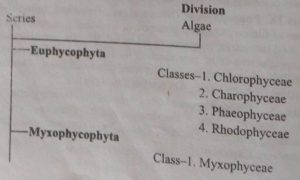
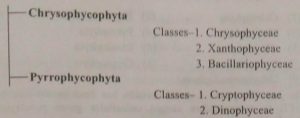
Stanier Van Niel (1962), Christensen (1962,64) and Round (1965) proposed the latest system for the classification of Algae. They are other modern algologists gave the classification as follows:
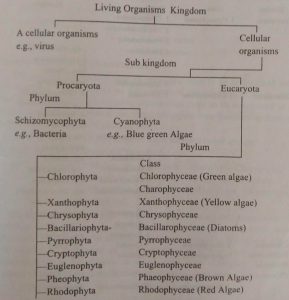
This sub kingdom Eucaryota also includes other plants – (Fungi, Bryophyta, Pteridophyta, Gymnosperms, and Angiosperms) and animals.
Prescott (1969) classified algae into nine classes in his, book “The Algae-a review” as follows:
(1) Chlorophyta
(2) Euglenophyta
(3) Chrysophyta
(4) Pyrrophyta
(5) Phaeophyta
(6) Rhodophyta
(7) Cyanophyta
(8) Cryptophyta
(9) Chloromonadophyta
The prochlorophyta a novel division has been established by Lewin (1976-77) to accommadate certain unicellular green procaryotic algae associated with marine didemind ascidiaris. (BSc 1st Year Botany Classification of Algae Sample Model Practice Question Answer Papers)
However most of the algologist classifies algae into the following eight divisions. The classes, order, families of some division are also given.

The committee on the International Code of Botanical Nomenclature has recommended the suffixes for use in the classification as follows:
Division (Phylum) – Phyta
Class – Phyceae
Sub-class – Phycedae
Order – Ales
Sub-order – Inales
Family – Aceae
Sub-family – Oideae
Geneus – A Greak name
Species – A Latin name
Modern Systems of classification
The gradual recognition that all organisms need to be reclassified into five kingdoms had its effect on the systems of classification of algae also. Blue green algae with prokaryotic organisation came to be recognised as a group much different from algae, many biologists even transferring then to bacteria under the name ‘Cyanobacteria’.
(A) F. E. Round (1973) classified algae into two major groups :
Gp 1. Procaryota – Phylum Cyanophyta
Gp 2. Eucaryota 12 Phylum (Euglenophyta, Chlorophyta, Charophyta, Prasinophyta, Xanthophyta, Haptophyta, Dinophyta, Bacillariophyta, Chrysophyta, Phaeophyta, Rhodophyta, Cryptophyta).
(B) H. C. Bold and M. J. Wyne (1978), following the suggestions of papenfuss (1946) for using the suffix ‘phycophyta’ divided algae into 9 divisions. However, to be non-committal with respect to blue-green algae (with regard to their algal or bacterial ancestory), they gave the name Cyanochloronta to the division of which these were consigned. The nine divisions of algae as per classification proposed by them, are :
-
- Cyanochloronta
- Chlorophycophyta
- Charophyta
- Euglenophycophyta
- Phaeophycophyta
- Chrysophycophyta
- Pyrrhophycophyta
- Cryptophycophyta
- Rhodophycophyta.
(C) K. R. Mattox and K. D. Stewart (1984) revised the classification of green algae on the basis of comparative cytology (mitochondrial phylogeny). They divided green algae into five classes-
(i) Micromonadophyceae (formaerly Prasinophyceae-Tetraselmis)
(ii) Charophyceae
(iii) Ulvophyceae
(iv) Pleurastrophyceae
(v) Chlorophyceae
However among the above classifications, Fritsch’s classification is more convenient, reasonable, accurate, and simple.
BSc 1st Year Botany Classification of Algae Sample Model Practice Question Answer Papers